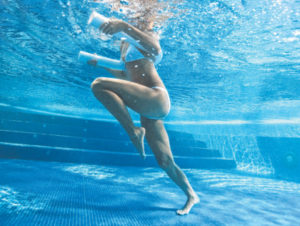 While biking, hiking, and running are among the most popular outdoor activities for this time of year, water aerobics can be a lower risk alternative to its more common counterparts.
While biking, hiking, and running are among the most popular outdoor activities for this time of year, water aerobics can be a lower risk alternative to its more common counterparts.
High impact activity, such as running, is a great way to burn calories and lose weight but can sometimes be rough on your joints. Water aerobics can be just as effective at trimming weight and gaining muscle, but is much gentler on your joints due to your body’s “weightlessness” during pool time. Water exercise also greatly lowers the risk of heat stroke or dehydration, common concerns during summertime for outdoor enthusiasts.
Water is about 800 times denser than air, making it much more difficult to move through. This means that some exercises performed in water (such as simple toning movements) could help you burn more calories than the same exercise performed on dry land. While your body is immersed in water, movement will not only require more effort but also the assistance of a wider range of muscles that might not get as much attention during regular exercise routines.
Those with back pain can also utilize the pool for a quick and easy therapy session. Studies show that the buoyancy and viscosity of water allows aquatic exercise to effectively develop improved balance and strength for spine therapy. These therapy techniques can include leg raises, floating, and stretching in the pool. Implementing some of these simple exercises into your day a few times a week could help relieve both upper and lower back pain.
While water aerobics is less likely to result in injury, there are still precautions everyone should take to ensure their safety. First, sunscreen is a non-negotiable addition to any activity that involves the outdoors, including swimming. Remember that spending time in water or excessive sweating calls for shorter times between re-application. Also keep in mind that though you might feel cool and sweat-free, exercising in water doesn’t replace the need for drinking plenty of it as well during workouts and throughout the rest of the day.
Further, though water provides resistance helping you build strength and tone, if your goal is to build muscle, try adding weights to either your water exercise routine or a weight training program in the gym. Also, if choosing to participate in pool exercises, check with your doctor first as chloramine compounds in swimming pools could cause skin and eye irritation.
Have you tried any pool exercises for physical therapy or pain management? Tell us about your experiences on our Facebook page.










